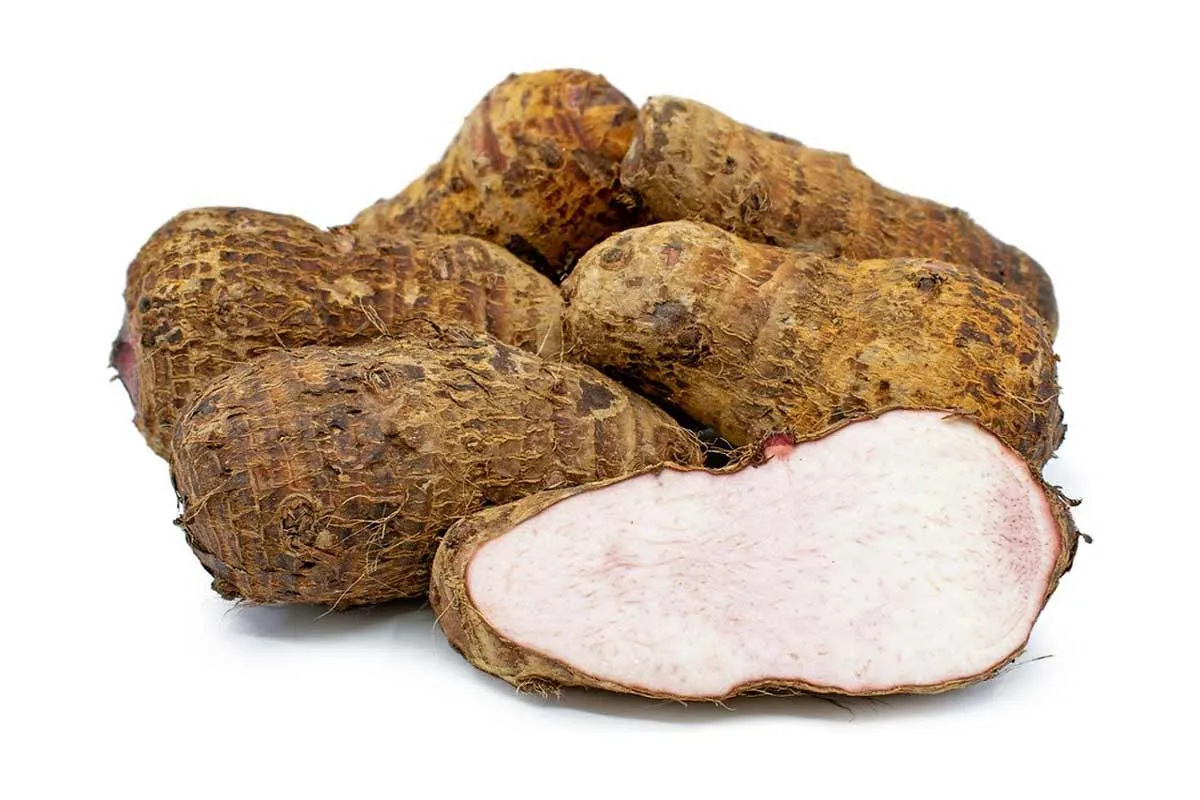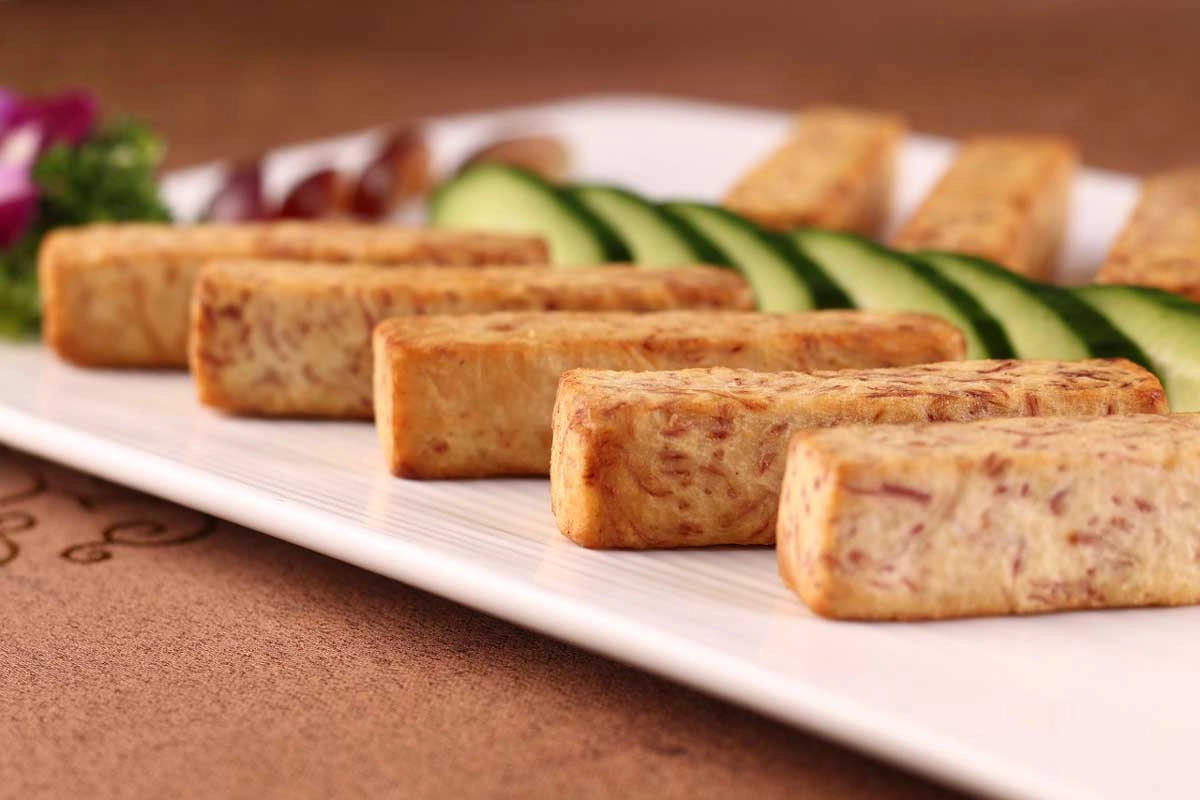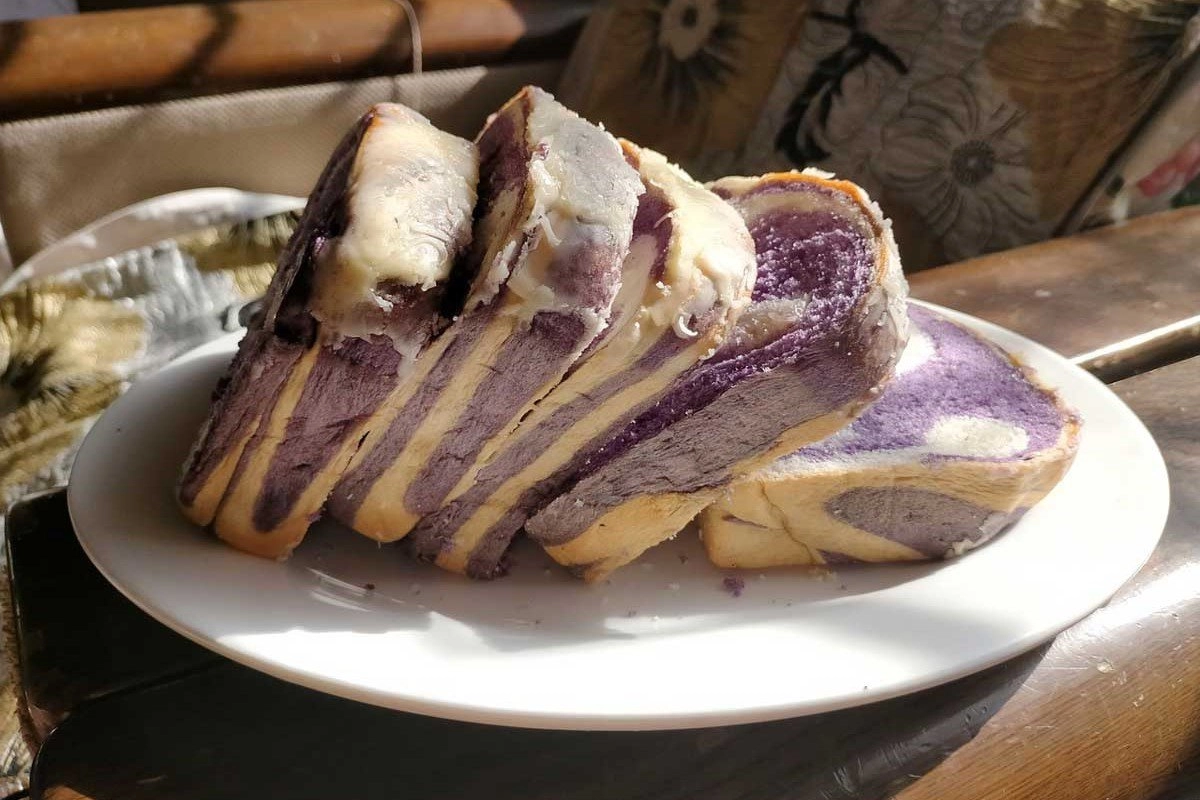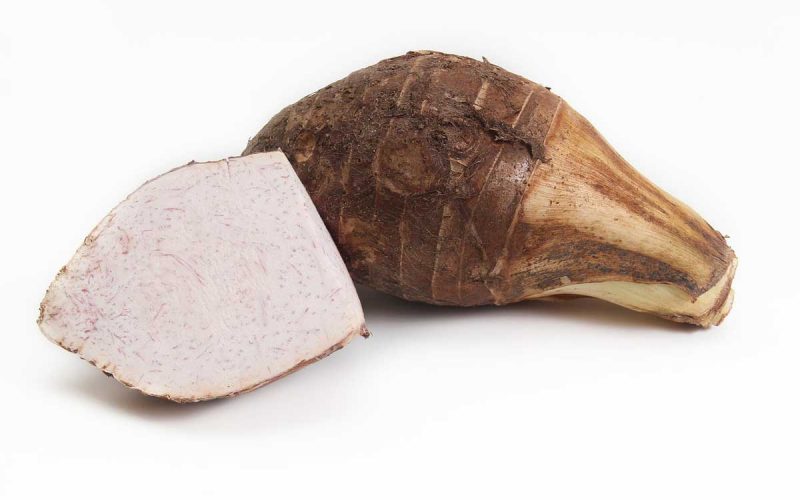Table of Contents Show
Taro root is utilized in many different cuisines across the world. It has a mild, nutty flavor, starchy texture, and nutritional advantages that make it healthier than other root vegetables such as potatoes.
Arbi, dasheen, and eddoes are some of the many names given to taro. As long as they have the same nutritional value, several kinds can be utilized consistently in your meals.
Taro Root is sourced from a tropical plant, Taro (colocasia esculenta) which is mainly grown for these edible corms.
15 Health Benefits of Taro Roots

1. Higher Amounts of Energy
Taro root is an excellent source of energy.
While many of us rely on protein bars to give us a rush of energy, top athletes commonly utilize taro root vegetable to provide that much-needed energy.
You should include taro roots in your pre-workout snacks because the energy they provide is both long-lasting and beneficial.
Some have even worked out recipes to make taro chips! These are incredibly delicious as well as nutritious, much like the sweet potato.
2. Promotes Weight Loss

Eating taro root keeps our stomach full for longer, allowing us to consume fewer calories throughout the day.
One of the main reasons why taro corm is such an excellent addition to your diet is that it may help you lose weight. It can have a significant impact on your weight loss journey.
Taro Roots also have a low glycemic index, which causes them to break down considerably slower than other vegetables. This process releases energy slowly while also requiring more energy to break down further, increasing your calorie deficit which is essential for weight loss.
According to one study, males who took a supplementation of 24 g of dietary fiber before meals consumed around 6% fewer calories and had lower insulin levels after the meal than the control group.
Animal studies have also revealed that rats fed resistant starch-rich diets had lower body fat and fat accumulation. This is thought to be attributed partly to resistant starch boosting fat-burning in your body, but further research is required.
As a good source of dietary fiber, Arbi can help protect you from overeating by keeping you satisfied for a lengthy period of time. Arbi contains 5.1 g of fiber per 100 g. Its low-calorie content further facilitates weight control.
3. Lowers Blood Pressure and Improves Muscle Health
Those who suffer from hypertension (high blood pressure) will tell you that salt is something to avoid. This veggie is ideal for the job.
It has low salt content, just enough to keep your kidneys functioning properly but not so much that you risk having a heart attack.
It contains significant magnesium and vitamin E quantities, all of which are proven to enhance metabolism and keep muscle mass in check.
Magnesium in your diet can help you improve your physical ability. It has been demonstrated to enhance gait speed, grip strength, and bodyweight activities.
Several clinical studies suggest that these healthy carbohydrates stabilize blood sugar, which aids in reducing body weight and may lower the chance of developing diabetes.
These starches are also acceptable for low-carb and ketogenic diets, according to the Dietary Guidelines.
4. Cleanses the Stomach
Taro root contains a high fiber content and is vital for GI tract health (gastrointestinal tract).
They constitute the majority of feces and help in peristalsis, the technique by which food moves through your small and large intestines.
Not only that, but it can help to establish the ideal habitat for bacteria in our gut, which, contrary to popular belief, is usually a positive thing.
Unlike potatoes, taro root has more than twice as much fibre. Constipation, diarrhea, stomach ulcers, and acid reflux all be relieved by consuming fibre from Taro roots.
Resistant starch improves colon health in pigs by increasing the synthesis of short-chain fatty acids and reducing damage to colon cells.
As an example, human studies have revealed that patients with ulcerative colitis tend to have lower amounts of short-chain fatty acids.
5. Helps in Preventing Cancer
According to current research, taro tubes cells were critical in preventing the regeneration of some types of cancer cells.
It can be related to the presence of plant-based chemicals known as polyphenols in taro tubes, which can lower the chance of getting certain forms of cancer.
There is some evidence that Quercetin (A powerful antioxidant) can kill cancer cells and inhibit the development of certain malignancies in test tubes and animals.
Even Taro Leaf is extremely nutritious and has a high level of antioxidants. It can also prevent heart disease and maintains your overall health.
6. Helps Strengthen Bones and Teeth
It can help you maintain your dental health and decrease your risk of fractures by promoting bone development and, eventually, increasing bone density.
Taro root is high in magnesium and vitamin E, both of which are important for preserving the structural integrity of your bones and teeth.
7. Rich Source of Amino Acids
Taro root, which is high in nutrients, is an unexpected source of amino acids.
Taro root includes almost 17 of the 20 naturally occurring amino acids and omega-three and omega-six fatty acids, which are essential for combating poor cholesterol and having a healthy lipid profile.
8. Helps In Controlling Blood Sugar Levels
It is also suggested for those who are at risk of acquiring type 2 diabetes since it helps regulate their glucose levels and lowers their chance of getting diabetes.
Taro has also long been utilised by diabetic people to satisfy their cravings without increasing their sugar levels.
Taro, like other starchy vegetables, contains relatively little sugars and a high fibre content, which again suppresses your appetite and allows for healthy eating.
9. Heart Health Improvements

Atherosclerosis is one of the world’s most significant and fastest-growing health issues in developing and industrialized nations.
There is no end in sight to these issues. Taro root is one of the foods that has been discovered to be a friend to humanity.
Due to its high levels of potassium, it can help reduce low-density lipoprotein (LDL) cholesterol and prevent atherosclerosis. Taro roots lower cholesterol levels in the body because of their high fiber content.
Taro is a zero fat and zero cholesterol meal, which means it has no cholesterol or fat. A high amount of vitamin E is also included in it, which helps prevent cardiovascular disease.
While we’re discussing organs, use of cooked taro root has also been linked to reducing the risk of kidney stones.
10. Retains Youthfulness and Vitality Throughout Life
Due to its high concentration of antioxidants, this starchy vegetable can significantly reduce stress on the body produced by free radicals.
Its capacity to stimulate cell development is a plus. Taro root helps improve healthier, younger-looking skin by reducing inflammation. As a result, blemishes, dark spots, and wrinkles are greatly reduced.
11. Vision is Improved

Beta-carotene and cryptoxanthin are potent antioxidants in taro roots. In addition to enhancing your vision, this miracle vegetable can also help you lose weight.
Along with this, it is widely acknowledged as a dietary adjustment one may make to avoid cataracts and many other eye diseases.
Taro root also includes lutein and zeaxanthin, which are considered to reduce the risk of light-induced oxidative damage that can lead to AMD (macular degeneration)
12. Boosts Immunity
The body’s defensive system against assaults from germs and viruses is the immune system. You never get the flu twice in flu season due to your immune system.
Immune systems are essential to our existence. Anti-infectious properties of vitamin C are known to protect the body against many common ailments, including COPD and the common cold.
Cell damage is prevented by antioxidants, which act to detoxify free radicals in the body and neutralize them.
As a great immunity booster, taro root is an excellent source of Vitamin C, which is found in high concentrations. It will increase the amounts of Vitamin C in your body and boost your immune system.
Fresh taro root is also abundant in Vitamin B6, which boosts your immunity by producing T cells and White Blood Cells.
While we’re discussing vitamins and minerals, one cup serving of taro can fulfill one-third of your recommended daily allowance (RDA) of Manganese!
13. Hair Growth is Improved by Improving Blood Circulation.
Your body needs iron and copper for healthy blood circulation. According to the American Heart Association, iron is a major component of blood and is mainly responsible for the transmission of oxygen in the body.
You can prevent an iron deficiency, tiredness, headaches, and loss of attention by using taro roots.
Taro roots are packed with folates and iron, which are important to new hair cell development and the health of your follicles.
Your hair will grow thicker and fuller thanks to these nutrients, which promote the creation of new strands.
14. Cooking

Both the roots and leaves of the taro plant have a delicious flavor. As for the leaves, they taste like cabbage when cooked.
Taro vegetable is also a popular dish in Southeast Asia. The young tuber of taro is baked along with chicken and coconut milk in Hawaii.
In addition to curries and cakes, taro roots may be fried for chips and pureed for purees, etc. Taro is a subsistence and valuable crop on the Pacific Island.
15. Has the Potential to Improve the Quality of Skincare
When we include taro root in our meals, our skin is well-protected by vitamin A and vitamin E. Our skin will recover faster, and a healthy shine will be restored to our skin due to these vital vitamins.
As a result, new and healthy skin cells are formed, and skin cells that have degenerated are soon rejuvenated. The appearance of blemishes and wrinkles on the skin can be reduced by ingesting Taro root frequently.
Also known as “the meal that works miracles for your skin”, taro root is a powerful anti-inflammatory and heal skin irritation.
How to Use Taro in Recipes?

Depending on what you want to use it for, choose a taro root.
The bigger ones have more flavor, while smaller types provide more moisture to the dish. Unblemished and solid, a root that is ready to eat has a hefty weight for its size.
Taro root should never be ingested raw, It is best to cook it before eating it.
In addition, it includes a bitter-tasting calcium oxalate molecule. Itchy mouth and throat if eaten raw; safe when cooked.
Remove the thick peel of the taro root with a knife while it’s under running water. As a result, there is less stickiness. You could even use a vegetable peeler for that.
Uncooked calcium oxalate might irritate your hands. The root of the taro plant is a highly versatile food. You can use a number of cooking methods to prepare it for a range of dishes.
To add even more vitamins and antioxidants to your dish, taro root leaves may be cooked and utilized as spinach.
In spite of its high carbohydrate content, taro root is low in calories and high in excellent resistant starches that support a healthy intestinal environment.
Half to one cup of taro root will offer substantial nutritious value to any dish, regardless of the size of the serving.
Comparing Taro and Ube Roots
Taro Roots
Taro is not especially purple in color among the most popular purple starches; the “corm” bulb primarily used in taro cooking resembles a coconut, being mid-brown and downy, with the insides ranging from bright white to a faint lavender.
Taro-flavored meals and drinks are frequently colored with food coloring for identification purposes. The inner texture is nearly gritty, yet it, like other starches, breaks down by boiling and mashing and is faintly sweet.
Taro powders, which are occasionally used in baking and taro milk teas, are sweet and more purple than that of the root itself. You could even find Taro powder at the nearest supermarket, and use it as a supplement to energize your meals.
By around 100 B.C., the taro plant, which originated in India and Malaysia, had spread to China, Taiwan, Hong Kong, and Japan.
It is a dominating taste in East And Southeast Asian baking, boba teas, and as a filling and flavoring in flaky puff pastries and chewy buns—as well as a powdered flavor mix for creamy milk, and steamed in pieces with pork shoulder or thick Chinese sausages in dim sum cakes.
After meals in Asian restaurants, it’s sometimes served in a hot coconut milk soup with tapioca pearls.
Ube Roots

Ube is widely consumed in the Philippines and Hawaii, where it is virtually solely used in sweets. It tastes like white chocolate or pistachio. It, like taro, is used as a powder in baking or boba.
To produce the jam-like ube halaya, using frozen or fresh ube root, which may then be used to make sweets like doughnuts, halo-halo, and pinwheel ube rolls.
Purple yams are very high in complex carbs, notably resistant starch.
“Resistant starch can be an excellent prebiotic fibre” Cabrero adds. “Prebiotics promote the growth of beneficial bacteria in the stomach and support the immune system.”






